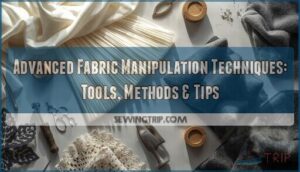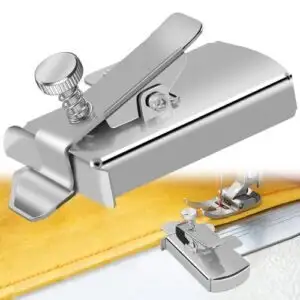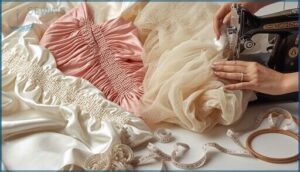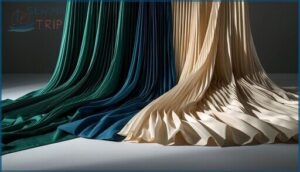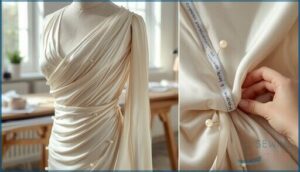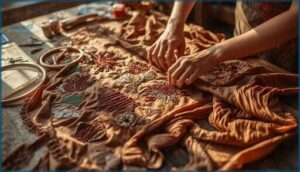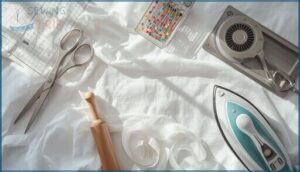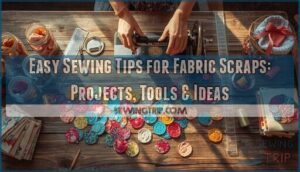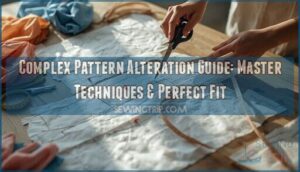This site is supported by our readers. We may earn a commission, at no cost to you, if you purchase through links.
When you gather silk into controlled waves or fold wool into architectural peaks, you’re working in the space where engineering meets artistry. Sophisticated fabric manipulation techniques transform flat textiles into dimensional surfaces—creating garments and installations that challenge how we perceive cloth itself.
These methods demand more than basic sewing skills; they require understanding how fibers respond to tension, heat, and structural intervention. Whether you’re shirring cotton into elastic sculptures, laser-cutting synthetic felts into lace-like patterns, or draping linen directly onto forms, each technique operates by exploiting specific fabric properties.
Mastering these approaches means learning to read your materials before you touch them, anticipating how weight and weave will behave under manipulation.
Table Of Contents
Key Takeaways
- Successful fabric manipulation hinges on matching specific material properties—weight, weave structure, and fiber content—to your chosen technique before you make the first cut, since mismatches cause roughly 78% of garment failures.
- Modern tools like magnetic seam guides, laser cutting systems, and digital embroidery have democratized complex techniques by delivering precision within 1-3 millimeters, reducing fabric waste from 30% to under 5%, and eliminating the guesswork that once required years of manual training.
- Combining multiple manipulation methods—such as layering smocking over laser-cut appliqué or pairing shirring with draping—demands systematic sample testing and deliberate planning, since stacking techniques without understanding their structural interactions leads to work that collapses under real-world stress.
- Pre-treatment steps like fabric pre-washing, grain alignment, and strategic interfacing application prevent the cumulative distortion that compounds through construction, transforming unpredictable materials into stable foundations that hold dimensional forms through wear and laundering.
Choosing Fabrics for Advanced Manipulation
Your fabric choice sets the foundation for every manipulation technique you attempt. The wrong material can unravel your work before you even finish, while the right one makes complex techniques feel surprisingly manageable.
Let’s break down what you need to know about selecting fabrics that’ll actually cooperate with your vision.
Best Fabrics for Complex Techniques
When complex techniques come into play, your fabric choice sets the foundation for success. Cotton, silk, linen, polyester, and Tencel dominate 2025’s sophisticated manipulation landscape—valued for woven strength and fiber content versatility. Tencel uses 50% less water than conventional options, addressing fabric sustainability without sacrificing performance.
Hemp and recycled PET are gaining ground in high-end work, offering durability that holds up under intensive pre-shrinking and interfacing choice demands.
In addition, embroidery is regaining popularity for its detailed craftsmanship.
Understanding Fabric Weight and Drape
Once you’ve chosen your fiber, fabric weight and drape become your make-or-break factors. Fabric weight—measured in GSM—directly influences how your piece moves. Lightweight fabrics (30–150 GSM) create fluid drape for blouses; medium weights (150–350 GSM) balance structure for trousers; heavyweight (350+ GSM) delivers rigidity for coats.
Climate effects matter: hot regions favor ultra-lightweight textiles 73% more often. Bias stretching increases drape but can distort seams. Interfacing influence shifts perceived weight, reducing natural movement. Understanding grams per square helps determine a fabric’s density and thickness.
Poor weight-drape matching causes roughly 78% of garment returns—choosing the right fabric means understanding these dynamics before your first cut.
Understanding weight-drape dynamics before your first cut prevents the fabric mismatches that cause 78% of garment returns
Woven Vs. Knit Fabrics
Weight and drape lead you straight to structural differences between woven and knit fabrics—and those differences reshape your manipulation toolkit.
Knits deliver 15–25% fabric stretch through their looped construction, while wovens offer negligible mechanical performance in extension (often under 5%). That dimensional stability makes wovens ideal for sculptural pleating and architectural folding; knits excel in body-contouring draping.
Your end-use applications depend on matching structure to technique.
Pre-washing and Stabilizing Methods
Before you begin gathering or pleating, pre-washing and stabilizing fabric locks in dimensions and prevents distortion. Cotton fabrics shrink around 5% after pre-washing, removing pre-treatment chemicals and establishing true measurements with measurement accuracy that matters for complex fabric manipulation techniques.
Your interfacing types determine structural stability:
- Fusible interfacing bonds instantly with heat—perfect for collars and cuffs
- Sew-in interfacing bolsters delicate fabrics without adhesive damage
- Medium-weight stabilizers match 80% of common cottons and linens
- Compaction treatments control knit elasticity and prevent distortion
Choosing and preparing fabrics through proper stabilization transforms unpredictable material into a reliable foundation for essential tools for fabric manipulation to work their magic.
Essential Tools and Materials
Your toolkit makes all the difference when you’re moving beyond basic sewing into complex fabric manipulation. The right measuring tools, machine attachments, and structural materials turn ambitious ideas into clean, professional results.
Let’s look at the essential equipment you’ll need to execute complex techniques with precision and confidence.
Measuring and Marking Tools
You can’t manipulate fabric with precision if you can’t measure it reliably. Start with a soft flexible body measuring tape for curved surfaces—tape measure accuracy improves with practice, so don’t second-guess yourself.
Choose marking tools with high visibility on your fabric, and confirm your fabric marker removal method before committing. Metal rulers offer greater material durability over plastic.
For angles, invest in dedicated angle measurement tools that won’t shift mid-project.
Magnetic Seam Guide Sewing Machine Attachment
For consistent seam allowances across complex techniques, a magnetic seam guide sewing machine attachment becomes one of your essential tools. This stainless steel ruler attaches magnetically to your machine’s metal needle plate, keeping fabric edges aligned within 1.5–3 mm accuracy improvement—critical when sophisticated techniques demand precision.
The ergonomic design and secure positioning deliver productivity gains on long seams and topstitching.
However, safety concerns arise with computerized machines; manufacturers warn strong magnets may interfere with electronics, so verify material compatibility with your specific model before investing.
Best For: Sewists and quilters working on mechanical machines who need repeatable seam allowances for garment construction, topstitching, or pieced quilts where accuracy within a few millimeters makes a real difference.
- Locks onto your metal needle plate with rare-earth magnets strong enough to stay put through thick fabrics like denim or canvas, so you’re not constantly readjusting mid-seam.
- Saves setup time once you’ve dialed in your allowance—no more marking lines or second-guessing where the edge should sit, especially helpful for production sewing or long quilt seams.
- Works across different machine brands as long as you’ve got a steel throat plate, and at under $20 it’s one of the more affordable ways to improve consistency without buying specialty feet.
- Not safe for many computerized machines—manufacturers explicitly warn the magnets can mess with sensors or control boards, which could void your warranty or cause malfunctions.
- Only grips ferrous metal, so if your machine has a plastic insert, aluminum plate, or limited exposed metal, the guide either won’t stick or will shift during sewing.
- Dragging it around can scratch your needle plate, and even with strong magnets some users report slight movement on high-speed stitching, which defeats the whole accuracy benefit.
Bobbin Case and Needle Types
Your sewing machine’s bobbin case and needle types directly affect stitch quality in sophisticated fabric manipulation techniques. Bobbin tension must balance with the upper thread for smooth lockstitches, while needle condition and point types determine whether your intricate work succeeds or suffers from skipped stitches and fabric damage.
- Match needle size to fabric weight: Use 70/10–80/12 for lightweight materials, 90/14 for medium-weight wovens, and 100/16–110/18 for heavy denim and layered seams
- Select point types strategically: Universal needles work for most wovens, ballpoint for knits, and microtex for precise topstitching on densely woven textured fabrics
- Replace needles regularly: Change after 8 hours of sewing to prevent stitch defects, thread breaks, and fabric compatibility issues that compromise professional results
Interfacing Options for Structure
Think of interfacing as your fabric’s invisible skeleton—it holds everything upright. Fusible versus sew-in choices depend on heat tolerance and desired softness, while interfacing weight must complement your fabric manipulation techniques without overwhelming the drape. Grain considerations align structure where you need it most, and sustainable options now match virgin-fiber performance.
Using interfacing for structure transforms flat fabric into architectural forms. Essential tools like fusible interlinings measurably increase bending rigidity in sophisticated fabric manipulation techniques, while printable versions achieve higher hand value. The Americas leads interlining consumption at USD 3.34 billion, with Asia-Pacific dominating manufacturing.
| Interfacing Type | Best Application |
|---|---|
| Fusible (68.4% market share) | High-volume production, collars, cuffs |
| Sew-in | Heat-sensitive fabrics, soft draping |
| Specialty (high-elasticity) | Activewear, stretch garments |
| Water-soluble | Temporary embroidery stabilization |
Core Advanced Manipulation Techniques
Once you’ve mastered your tools and chosen the right fabrics, it’s time to shape them into something special. The techniques you’re about to explore range from traditional methods like gathering and smocking to modern technologies that push creative boundaries.
Each approach offers unique ways to add dimension, texture, and visual interest to your work.
Gathering, Shirring, and Smocking
Gathering, shirring, and smocking transform flat fabric into dimensional textile sculptures. Each technique manipulates fullness differently—gathering ratios usually range from 2:1 to 3:1, while elastic gathering through shirring spacing at 1–1.25 cm intervals creates controlled stretch.
Smocking history reveals centuries-old embroidery-based methods that predate elastic, now replicated through machine smocking techniques. Essential tools include flexible measuring tape and sophisticated stitch length for fabric manipulation techniques.
Pleating and Sculptural Folding
Pleating transforms fabric into architectural structures—knife, box, and accordion pleat variations each create distinct visual rhythms. Your fabric stiffness determines whether folds hold crisp lines or soft cascades.
Industrial pleating machines now produce intricate three-dimensional designs at scale, influencing fashion trends toward sculptural elements.
Precision folding requires accurate pattern adjustments and heat-setting for synthetics. Fabric manipulation techniques through fabric folding reveal dimensional possibilities in your textile work.
Draping and 3D Fabric Shaping
Moving beyond set folds, draping lets you sculpt fabric directly on a mannequin—creating three-dimensional designs that respond to body contours. Bias draping exploits diagonal grain for stretch, while structural draping builds volume through calculated tension. Your fabric weight determines success: lightweight silks flow naturally, but heavier materials resist shaping. Robotic draping now automates complex surface texturing, though hand manipulation remains unsurpassed for nuanced textile manipulation.
- Bias-cut wovens and knits adapt best to curved forms and expressive shaping
- Medium weight fabrics (4-8 oz/sq yd) balance drape with structural integrity
- Pin fabric tensions strategically to preview folds, gathers, and sculptural silhouettes
- Fabric manipulation techniques combine draping with pleating for dimensional effects
Laser Cutting and Technological Methods
While hands-on techniques remain foundational, laser cutting and technological methods reshape what’s possible in sophisticated fabric manipulation techniques. Textile technology delivers laser precision that manual cuts can’t match—intricate designs emerge at speeds reaching 590 mm/s. Automation integration slashes waste reduction from 30% scrap down to under 5%, while design complexity expands to include micro-perforations and three-dimensional designs. Market growth reflects this shift: the laser fabric cutting sector will hit USD 2.8 billion by 2032, proving that creating intricate designs now demands digital fluency alongside traditional skill.
| Technology Method | Key Capability | Efficiency Gain |
|---|---|---|
| CO₂ Laser Systems | Clean-edge cutting at 400–600 mm/s | 96–98% material utilization |
| AI-Controlled Cutting | Pattern nesting, cycle time reduction | 83% faster than manual methods |
| Fiber Laser Engraving | Micro-detail etching, no contact drag | Zero edge fraying on technical fabrics |
| Digital Nesting Software | Optimized fabric layout algorithms | Up to 96% yield on patterned cloth |
| Robotic Manipulation | Automated draping, consistent tensioning | 75% reduction in labor hours |
Laser cutting provides opportunities you didn’t know existed—lace effects that would take hours by hand materialize in minutes, and your material costs drop as fabric waste shrinks from 15% to below 1%. You’ll find this precision especially influential for weaving complex motifs into garments or creating sculptural cutouts that maintain structural integrity. Automation integration doesn’t replace your design eye; it elevates it, letting you prototype faster and push boundaries in textile technology that manual methods can’t reach.
Creating Texture, Patterns, and Embellishments
Once you’ve mastered the foundational techniques, the real fun begins with adding texture and surface decoration to your work. These methods turn flat fabric into something that catches the eye and invites a closer look.
You’ll find that each approach offers its own way to build depth, pattern, and visual interest into your garments.
Quilling, Curling, and Open Work
With fabric quilling tools and stabilizer application, you can coil narrow bias strips into sculptural rosettes—bias strip flexibility lets you curl tight radii without cracking. Open work fabrics like eyelet add controlled transparency, while 3D textile layering builds relief through stacked coils.
These sophisticated fabric manipulation techniques for creating intricate designs transform flat yardage into dimensional statements.
Fraying for Raw Textured Effects
Where curls and coils bring polish, controlled fraying offers raw visual punch. Controlling fray on loosely woven linens or chiffon introduces surface texturing that evolves with wear. Laundering effects accelerate edge degradation, so you’ll want to pair tightly woven fabrics with stay-stitched seam strength for design applications.
Sophisticated fabric manipulation techniques like pinking or liquid sealant let you script precisely how much textile art each raw margin reveals.
Embroidery and Thread Work
You can improve any garment from plain to powerful with strategic embroidery and thread work. Machine embroidery delivers precision with 75/11 needles for medium fabrics, while hand embroidery grants you full artistic control over stitch types and thread selection.
Digital embroidery streamlines complex motifs, requiring stabilizers matched to stitch density. Fabric manipulation techniques demand understanding: fine 60/8 needles suit delicate monograms, and proper thread work transforms standard sewing techniques into dimensional art.
Appliqué, Sequins, and Goldwork
With appliqué, you’re tapping into techniques that date back centuries—from Baltimore’s layered 3D effects to modern laser-cut precision. Goldwork methods, refined since China’s Eastern Han Dynasty, use metal threads for luxurious dimension.
Sequins transform garments into statement pieces, with the global market hitting USD 16.56 billion in 2024.
These sophisticated embellishments define industry impact across fashion segments.
Tips for Precision and Professional Results
Mastering sophisticated fabric manipulation isn’t just about knowing the techniques—it’s about executing them with precision that separates amateur work from professional results. The difference often comes down to how you prepare, handle, and finish your materials throughout the process.
Here’s what you need to focus on to improve your fabric manipulation work to a professional standard.
Marking and Cutting Techniques
Precision in marking and cutting separates novice work from professional results. Digital projection and laser guidance systems reduce placement errors to under 1 mm, while automated cutting slashes fabric waste by 3–5 percentage points—a genuine sustainability impact.
Your marking and cutting techniques should include:
- Pattern alignment cameras that catch print mismatches before you cut
- Ultrasonic blades for clean edges on synthetics without fraying
- Nested layouts that squeeze every usable inch from your yardage
- Chalk-free digital markers for fabrics that show every smudge
- Layer-cutting machinery processing multiple plies in one pass
Preventing Fabric Distortion
When your manipulation work warps or twists after just one wash, grain alignment and pre-washing effects are usually the culprits. Staystitching benefits curved edges by locking them before stress hits, while knit spirality demands relaxed drying before you cut. Seam pressing after each step prevents cumulative distortion that compounds through construction.
| Distortion Trigger | Prevention Strategy |
|---|---|
| Off-grain cutting | Align warp/weft threads before pattern placement |
| Knit spirality | Pre-shrink yardage, trim distorted selvages |
| Bias stretch | Staystitch curves, press—don’t slide—your iron |
Combining Multiple Manipulation Methods
When you stack smocking over laser-cut appliqué or layer shirring beneath draped folds, design integration determines whether your hybrid technique design succeeds or collapses under its own weight. Multi-technique combinations demand sample testing—robotic manipulation success rates prove that sophisticated fabric manipulation techniques improve by 80% with structured planning.
Combining appliqué with other techniques creates dimensional texture and three-dimensional designs while supporting sustainable textile recycling through deliberate layered fabric effects.
Finishing Seams and Edges
Your fabric manipulation won’t survive a single wear if edge treatments and seam finishing lack structural integrity. Seam strength and puckering control become non-negotiable when sophisticated fabric manipulation techniques meet real-world stress.
- Overlock machines secure raw edges on armholes and hemlines before finishing operations
- Double-fold hems reduce fraying on high-stress edges while maintaining visual line quality
- Facings stabilize curved necklines created by sculptural manipulation
- Stitch density at 6 per centimeter delivers 21% less seam opening along bias edges
- Grain alignment keeps hemlines parallel to the floor, preventing edge distortion
Frequently Asked Questions (FAQs)
What is fabric manipulation?
Over 60% of avant-garde runway garments rely on shaping fabrics—folding, gathering, or layering flat cloth into three-dimensional form.
Fabric manipulation creates texture and volume, transforming fabric alteration into aesthetic enhancement and functional design creation through core fabric manipulation techniques.
What is textile manipulation?
Textile manipulation reshapes fabric through intentional modification, transforming surface design and texture alteration.
These creative applications exploit material properties like elasticity and drape, producing unique effects across textile art, costume design, and fabric manipulation techniques.
What materials do you need for fabric manipulation?
Picture a designer reaching for silk organza—but without the right needle types, stabilizer films, and rotary cutters, even the best fabric selection fails.
You’ll need measuring tools, boning materials, elastic threads, and fabric adhesives for sophisticated techniques.
How can a simple fabric be transformed into an extraordinary artwork?
You start by combining techniques like laser cutting with embroidery—modern fabric manipulation techniques layer cutwork, thread painting, and sculptural folding to create textile art that transforms simple material into dimensional texture with artistic expression and creative transformation ideas.
How do you reverse applique fabric?
You layer two fabrics right-sides-out, stitch around your design, then carefully cut away the top layer to reveal the contrasting fabric beneath—creating dimensional texture through this precise reversal of traditional appliqué.
What is the relationship between fabric and design?
Fabric properties define design constraints while enabling creative expression. Understanding drape, weight, and structure fosters progress in garment construction.
Your fabric selection determines functional design outcomes and visual appeal through sophisticated manipulation techniques.
How do you manipulate stretch fabrics without distortion?
Like catching water in your hands, working with stretch fabric requires a gentle touch. You’ll need ballpoint needle types, balanced tension, proper stitch parameters, and stabilization methods to prevent fabric distortion while maintaining elasticity throughout complex fabric manipulation techniques.
What causes fabric manipulation to lose shape over time?
Over time, fiber degradation weakens textiles through mechanical stress and friction damage. Washing effects strip elasticity, while poor tension control accelerates fabric distortion.
Preventing these issues requires understanding how sophisticated fabric manipulation techniques interact with everyday wear.
Can you reverse or undo fabric manipulation techniques?
Attempting to reverse gathered seams or laser cuts is asking your fabric to forget—most manipulations leave permanent fiber memory, stitch holes, or structural changes.
Reversibility challenges multiply with sophisticated techniques; professional restoration may reduce damage but rarely erases design intent completely.
How do you calculate fabric yardage for manipulated designs?
You’ll multiply your finished measurement by the gathering or pleating ratio—usually 5:1 for light ruffles or 5:1 for smocking—then add waste allowance and adjust for fabric width before converting to yards.
Conclusion
The notion that sophisticated fabric manipulation techniques are reserved for couture ateliers doesn’t hold up under scrutiny. You’ve now seen how accessible tools—magnetic guides, strategic interfacing, even controlled fraying—democratize methods once guarded by master craftspeople.
Your ability to transform flat textiles into dimensional forms depends less on expensive equipment than on understanding how fibers respond to stress and structure. Start with one technique, master its logic, then layer methods deliberately. That’s where true innovation begins.
- https://www.marketsandmarkets.com/PressReleases/smart-textiles.asp
- https://www.researchandmarkets.com/reports/5939399/smart-textiles-market-report
- https://www.grandviewresearch.com/industry-analysis/4d-printing-market
- https://www.accurl.com/blog/laser-cutting-accuracy/
- https://marketintelo.com/report/laser-cutting-fabric-market

